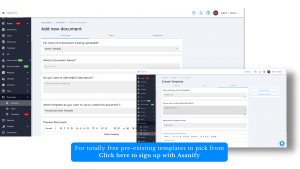Getting a new employee on board is always exciting! Both for you and your new employee. But how do you ensure that this excitement is maintained through great experiences and a seamless onboarding? In this blog, I have focused on the appointment letter. This is the letter you send to your candidate once you have selected them for the job.
You can even download the letter format template and customise it based on your requirements.
I have covered the following,
- What is an appointment letter?
- What’s the difference between an appointment letter and an offer letter?
- What should you include in an appointment letter?
- When should you give the candidate an appointment letter?
- Dos and Don’ts of an appointment letter
- Summary
- FAQs
Download the appointment letter template for free now!
What is an appointment letter?
A letter of appointment is a document that you send out to a candidate you have selected for a job. It is a formal document issued by the organization that has selected the candidate. It confirms that the candidate has been “appointed” for the job they applied for.
An employment contract is also another name for this letter.
Typically, when a candidate finishes a successful selection process, HR gives them an offer letter. This is the first document they receive from the company. After that, the candidate accepts or rejects the offer. Then, the HR or employer may (or may not) negotiate the salary with the employee. After ironing out all the finer details, HR rolls out the employment contract to the candidate. This contains all confirmed details of the job for the employee.
What’s the difference between an appointment letter and an offer letter?
While both these are written at the same time in the employee life cycle, the purpose of writing them a very different.
An offer letter is written to a selected candidate for the sole purpose of telling them that they have been selected for the job role. The acceptance of the offer letter is a crucial step before issuing the appointment letter.
While, on the other hand, an appointment letter is written and sent to the candidate as proof of employment. It often contains details about the job. Information such as job title, location, job description, date of joining, salary, stipend or package and so on (the next section of this blog includes a list of things to include).
Elements of an Appointment Letter
An appointment letter typically includes several key elements that outline the terms and conditions of employment. These elements may vary depending on the organization and the specific job role, but generally include:
-
Job title and department: Clearly state the position the candidate is being appointed to and the department they will be working in.
-
Reporting manager’s name: Mention the name of the person the new employee will report to, providing a point of contact within the organization.
-
Start date: Specify the date when the candidate is expected to begin their new role.
-
Compensation details: Include information about the salary, benefits, and any other compensation the employee will receive.
-
Job responsibilities and expectations: Outline the main duties and responsibilities associated with the job, giving the candidate a clear understanding of what is expected of them.
-
Probationary period details: If applicable, mention the duration of the probationary period and any conditions associated with it.
-
Company policies and procedures: Provide an overview of important company policies and procedures that the employee needs to be aware of.
-
Signature block for the appointing authority: Include a space for the appointing authority to sign, making the document official.
These elements provide a clear understanding of the job role, expectations, and terms of employment, and serve as a formal agreement between the employer and employee.
How to write an appointment letter to employee? (What should you include)
Now that we know what an employment contract is, let us deep dive into what we should include in the letter. So, let’s have a look!
- Start by adding the company header
- Congratulatory statement for the new employee
- Employee’s job title or job role
- Employment type (full time, on probation or part-time and so on)
- Job description
- Date of joining. This should also include details about the candidate being required to come early on the first day (if necessary)
- Job location (Apart from the regular offline, online hybrid work mode, mention the geographical location and postal address in case the candidate needs to travel to some new location)
- You should include the conditions under which the employee has been given the job. (In a lot of cases, say you’re hiring a fresher, you require them to maintain a minimum academic grade until they graduate and join your company. Other cases may include other conditions under which an employee is hired. It should be mentioned here)
- Typical working hours
- Include next steps and deadlines for them
- Documents to be submitted
- Mention employee’s chances of getting transferred by everyone
- Employee salary along with the salary structure and other benefits
- Additional information such as dress code
- Your phone number or email id so they can contact you in case of any doubts
- Be sure to conclude the letter with the company stamp or seal (as per company policy)
Types of Appointment Letters
There are various types of appointment letters, each serving a specific purpose. Some common types of appointment letters include:
-
Job appointment letters: These letters confirm an individual’s appointment to a specific job role within an organization.
-
Academic appointment letters: These letters confirm an individual’s appointment to a teaching or research position at an academic institution.
-
Board appointment letters: These letters confirm an individual’s appointment to a board of directors or other governing body.
-
Internship appointment letters: These letters confirm an individual’s appointment to an internship or training program.
-
Contract appointment letters: These letters confirm an individual’s appointment to a contract or freelance position.
Each type of appointment letter serves a specific purpose and includes relevant details and information.
Appointment letter format
[Company Letterhead]
Date: [dd/mm/yyyy]
Subject: Appointment Letter
To,
[Candidate’s Full Name]
[Address Line 1]
[Address Line 2]
Dear [Candidate’s Name],
We are pleased to offer you the position of [Job Title] at [Company Name]. Your appointment will be effective from [Start Date] and is subject to the terms and conditions outlined below.
Terms and Conditions:
- Position and Reporting: You will be appointed as [Job Title] and will report to [Supervisor’s Name/Designation].
- Compensation: Your gross annual salary will be ₹[Amount], subject to applicable taxes and deductions.
- Working Hours: Your regular working hours will be from [Start Time] to [End Time], Monday to Friday.
- Probation Period: You will be on probation for a period of [Duration]. Upon successful completion, your appointment will be confirmed.
- Confidentiality: You are required to maintain confidentiality of all company information and comply with the company’s policies.
- Termination: Either party may terminate this agreement with [Notice Period] notice or salary in lieu thereof.
We are confident that your skills and experience will be an excellent addition to our team. Please sign and return a copy of this letter as a token of your acceptance.
We look forward to working with you and wish you a successful career at [Company Name].
Sincerely,
[Authorized Signatory Name]
[Designation]
[Company Name]
[Contact Information]
Is an Appointment Letter a Legal Document?
An appointment letter is a formal document that confirms an individual’s appointment to a specific position or role within an organization. While it is not a legally binding contract in and of itself, it can be considered a legal document in certain circumstances.
Once signed and accepted by the employee, an appointment letter can be considered a legally binding agreement between the employer and employee. It outlines the terms and conditions of employment, including job responsibilities, compensation, and benefits, and serves as a formal record of the employment agreement.
However, it is essential to note that an appointment letter is not a substitute for a formal employment contract. In some cases, an employment contract may be required to outline specific terms and conditions of employment, such as non-disclosure agreements or non-compete clauses.
In summary, an appointment letter is a formal document that confirms an individual’s appointment to a specific position or role within an organization. While it is not a legally binding contract in and of itself, it can be considered a legal document in certain circumstances and serves as a formal record of the employment agreement.
When should you give an appointment letter to employee?
An appointment letter can either be written by the HR manager, team lead or department manager or even by the founder (in the case of smaller companies).
An appointment letter is usually given out to the candidate after the offer letter.
It is written on the official company letterhead. The norm is that the employer signs and keeps one copy with himself or herself while the employee (newly joining candidate) also keeps a signed copy with himself/herself)
An appointment letter is usually given to the candidate on their first day of joining.
Dos and Don’ts
Now, here are a few dos and don’ts to keep in mind while writing an employment contract
- Be as clear and precise as possible. Don’t leave out the necessary information just to keep the candidate guessing. Give as many details as you can, wherever possible and don’t leave anything up for guessing.
- Ensure the tone of the appointment letter is happy and excited. Remember, this is a very exciting time for your new candidate.
- Keep it brief and genuine. Don’t go on and on about how you think they’ll do such an amazing job with the new role. Here, short and sweet is the way to go!
- Grammatical or linguistic errors are a total no no! There’s nothing worse than an error or a typo in the to show the candidate that you don’t care
- Don’t use language that makes the appointment letter sound like a contract. I know I said that the employment contract is a contract and should be formal. But if you make it sound too formal, it might scare the candidate into thinking that you are way too particular about unnecessary things. So make it sound friendly.
- Lastly, don’t forget to add your phone number or email id at the end of the appointment letter so that the candidate can get in touch with you if they have any queries or doubts.
How to write an appointment letter – Summary
You now know how to write the perfect appointment letter to get your employee excited!
But why do through the trouble? Using the correct letter format can make the process smoother and more professional.
Click here to download the appointment letter template
or on the image below to sign up with Asanify where you can use pre-existing templates that can be auto-fill through our HRMS based on your requirements
FAQs
No, it is not. The employee or candidate cannot take any legal actions against the employer in case they withdraw the employment opportunity
Yes, if the employer so sees fit, it is his/her right to withdraw the letter.
An employment contract should definitely include,
1. Job role or title
2. Job description
3. Salary and other benefits
4. Joining date
5. Other terms and conditions
Not to be considered as tax, legal, financial or HR advice. Regulations change over time so please consult a lawyer, accountant or Labour Law expert for specific guidance.





